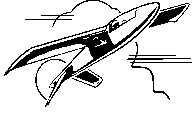









Fuselage
The Mini-IMP fuselage has 3 main bulkheads.
The front, or “nosewheel”, bulkhead carries the nosewheel, rudder
pedals and nosewheel “box”. The
rear of this “box” carries the instrument panel and the floorboards attach
to its sides. The instrument panel
is so arranged as to have a center panel and two side panels in order to give
more room for radios and instruments. These
side panels and center panel attach to two basic structural angle panels which
form the structural sides of the fuselage, as well as the arm rests, seat
support, and mount for the flight controls and landing gear control system.
A modest baggage space behind the seat (which tilts forward for access)
provides the structural attachment to the main bulkhead.

The second main bulkhead carries the wing
above it, the engine behind it, and the main landing gear beneath it.
The wing is attached with two basic fittings which have been statically
tested to 14 g loading (at 900 pounds gross weight).
Even then, these fittings did not fail catastrophically, but merely bent
slightly. Since the engine, pilot, fuel, and landing gear are all
attached to this single component, the basic structural simplicity of the
Mini-IMP is obvious.
The top of the engine compartment aft of the
main bulkhead is a tension web which takes the normal down loads on the tail.
This web is suitably strengthened for negative loads which might be
imparted in aerobatic flight. The
tail “boom” consists of a flat-wrapped sheet metal cone structure which uses
2 identical skin halves. The tail skin together with sheet metal channels at top
and bottom, as well as 4 standard angle extrusions to stiffen the cone, carry
the thrust loads of the propeller, and provide adequate attachment of the
inverted “V” tail surfaces. The
two tail surfaces are attached to the tail cone through aluminum plate
attachment fittings which in turn bolt to a semi-bulkhead for the front
stabilizer spar and a ring bulkhead for the rear stabilizer and elevator-hinge
spar.
There are no welded fittings other than the
engine mount (which is available pre-manufactured). While the entire aircraft is designed for an ultimate load
factor of 6 g’s, it is apparent that the structure will obviously accommodate
even higher loading, although this might be very difficult to accomplish, even
deliberately.
 Mini-IMP
Aircraft Company
Mini-IMP
Aircraft Company 